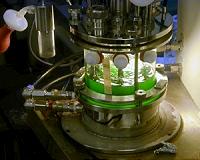 |
Washington DC (SPX) Nov 08, 2010 A common roadside plant could have the right stuff to become a new source of biofuel, according to U.S. Department of Agriculture (USDA) studies. Scientists with the Agricultural Research Service (ARS), USDA's principal intramural scientific research agency, have found that field pennycress yields impressive quantities of seeds whose oil could be used in biodiesel production. Field pennycress belongs to the Brassicaceae family, along with canola, camelina and mustard-other prolific producers of oil-rich seeds. The ARS studies help support USDA's efforts to develop new sources of bioenergy. At the ARS National Center for Agricultural Utilization Research in Peoria, Ill., chemists Bryan Moser, Gerhard Knothe and Terry Isbell and plant physiologist Steven Vaughn formed a team to study field pennycress' potential. The scientists obtained oil from wild field pennycress, pretreated it with acid, and used a type of alcohol called methanol to react with the field pennycress oil to produce both biodiesel and glycerol. After some additional refining, the finished biodiesel was tested to see if it met the biodiesel fuel standard established by the American Society for Testing and Materials. The results suggested that, with some work, the previously problematic pennycress could become a commercial commodity. All diesel-based oils start to gel when it's cold enough. So the cloud point, which is the temperature at which crystals become visible in the fuel, is a crucial factor in both biodiesel and petrodiesel production. Another important property is the pour point, the temperature at which the fuel fails to pour as a result of excessive solidification. The average cloud and pour points for field pennycress biodiesel were 14 degrees Fahrenheit (minus 10 degrees Celsius) and minus 0.4 degrees Fahrenheit (minus 18 degrees Celsius), respectively. These temperatures were well below the cloud and pour points of soybean oil-based biodiesel. This result suggests that field pennycress biodiesel is better suited for use in cold climates than many other biodiesel fuels, such as soybean oil-based biodiesel. Another plus: Pennycress can be grown during the winter and harvested in late spring, so farmers who cultivate pennycress can also maintain their usual summer soybean production without reducing crop yields.
Share This Article With Planet Earth
Related Links Agricultural Research Service at USDA Bio Fuel Technology and Application News
 Algae-Based Biofuels Annual Production To Reach 61 Million Gallons By 2020
Algae-Based Biofuels Annual Production To Reach 61 Million Gallons By 2020Boulder CO (SPX) Nov 04, 2010 In the face of petroleum scarcity, increasing oil prices, market volatility, and climate change, leaders in government and industry are looking to renewable fuel sources such as algae-based biofuels to reduce expenses and mitigate their acute vulnerability to petroleum supply chains. Yielding 2 to 20 times more oil per acre than leading oilseed crops, algae's productivity and scalability a ... read more |
|
| The content herein, unless otherwise known to be public domain, are Copyright 1995-2010 - SpaceDaily. AFP and UPI Wire Stories are copyright Agence France-Presse and United Press International. ESA Portal Reports are copyright European Space Agency. All NASA sourced material is public domain. Additional copyrights may apply in whole or part to other bona fide parties. Advertising does not imply endorsement,agreement or approval of any opinions, statements or information provided by SpaceDaily on any Web page published or hosted by SpaceDaily. Privacy Statement |